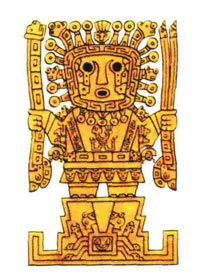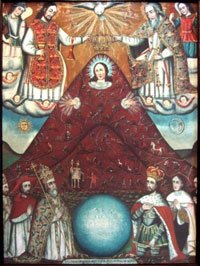 The Catholic religion was the official religion of Bolivia until 2009 when the New Bolivian Constitution was approved and Bolivia became a secular country.
The Catholic religion was the official religion of Bolivia until 2009 when the New Bolivian Constitution was approved and Bolivia became a secular country.
During the colonial period, the Spanish were intolerant of indigenous beliefs in Central and South America. To convert the "natives" they made use of severe measures, such as building Christian churches above indigenous temples. As a result, the indigenous people adopted the Christian religion while still practicing their own, and from the fusion of these beliefs arose syncretism which is characteristic of Latin American culture.
There are predominantly two cultures in the Andean world, the Aymara and the Quechua. Both worship the Pachamama: Mother Earth.
As a result of the Catholic religion being supeimposed, many gods of the indigenous people continue to be worshiped through Christian saints. One example of this is the symbiosis of the Pachamama with the Virgin Mary. Likewise, with the Tunupa god who is identified with Saint Bartholomew, or Illapa who is associated with the image of Grandpa Santiago.
 Nevertheless, the issue is more complex than this. As Silvia Rivera has commented, there is a reductionism in the idea of the western Andean that does not clearly reflect the cultural patterns one expects from the mix. The author suggests that modern reading of the mestizo follows a pattern of justifying colonial relationships.
Nevertheless, the issue is more complex than this. As Silvia Rivera has commented, there is a reductionism in the idea of the western Andean that does not clearly reflect the cultural patterns one expects from the mix. The author suggests that modern reading of the mestizo follows a pattern of justifying colonial relationships.
In addition, Gisbert goes back to Saint Augustine's thesis to explain religious syncretism in South America and states that "for the 16th Century Spaniard it was difficult to accept that God had left all of humanity in complete ignorance of the truths of faith with the resulting impossibility of obtaining their salvation." The result of this thinking along with the persistence of the natives to preserve their beliefs is the source of identifying indigenous deities with the Virgin Mary and the Christian saints.
Syncretism in Bolivia includes many myths and theories which cannot be denied since the country has a rich cultural component arising from the variety of beliefs and customs that produced a huge range of artistic statements full of mysticism, rhythms and colors when they are combined.
José de Mesa, Teresa Gisbert: HISTORIA DE BOLIVIA; cuarta edición, Editorial Gisbert, La Paz, 2001
Gisbert, Teresa. El paraíso de los pájaros parlantes, 1999. Iconografía y mitos indígenas en el arte, 1994. Rivera, Silvia. Pachacuti: los horizontes históricos del colonialismo interno en violencias encubiertas en Bolivia,1993.


